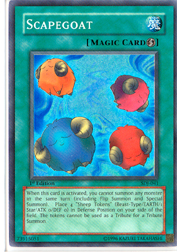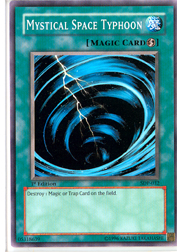Today, I’m going to talk about the side deck, a fifteen-card arsenal that can often turn the tide of a match in your favor. While many players underestimate the importance of the side deck and stick solely with the main deck, a tactical duelist is always scouting an opponent’s deck and making note of potential counters for later games.
For the true tactician, the side deck should fulfill two purposes.
Reinforcing the Main Deck’s Theme
No matter how well-constructed, all decks have weaknesses. Since no single deck can have the upper hand against all other decks, you can use your side deck to make up for any problems that your main deck is having in a particular matchup.

Let’s say that you’re running a deck that features numerous monsters with low DEF values. You’re trying to use cards like
Magician of Faith,
Apprentice Magician, and
Scapegoat to conserve your cards in hand while steadily reducing your opponent’s options. The deck is stable and can play defensively, but certain builds can wreak havoc against it. Imagine that your opponent has summoned
Enraged Battle Ox. Your solid defensive strategy has just turned into a liability, and you’ll be taking massive damage each turn unless you can adapt. It becomes obvious that the main deck needs some support. You might want to switch in some high ATK monsters or some defensive traps to stop the onslaught.
Let’s say you’re running a deck that tries to control the graveyard with cards like
Kycoo the Ghost Destroyer. Because a 2000-ATK powerhouse like
Berserk Gorilla can destroy your field presence, cards such as
Windstorm of Etaqua and
Enemy Controller will be necessary substitutions from the side deck.
Or let’s say you want to prevent your copy of
Mystic Tomato from being hit by
Nobleman of Crossout. Your side deck strategy could be to switch in a copy of
Ceasefire to protect your cards.
There are lots of cards in the game that were designed to stop certain deck themes. But not all counters are created equal. When you play in a major tournament, you can never be sure what decks you’ll be facing. Cards that counter the
Sacred Phoenix of Nephthys and
Vampire Lord build can fail miserably against a typical Warrior Chaos deck. Be sure to watch out!
Changing Tactics
Who’s Going First?
This is where the term “tactical side decking” comes into play. It refers to choosing one side deck option over another based on certain conditions in a duel.
Many players don’t appreciate the value of the coin flip or die roll enough, but the advantage of going first is akin to having the serve in tennis or playing white in chess.

Going first means that you’ll always draw a card before your opponent. It also allows you to place key cards before your opponent can disrupt them. After all, a copy of
Dust Tornado or
Mystical Space Typhoon hitting your first-turn defenses can mean the difference between a win or a loss. Because the issue of who’s going first is usually settled after the first game (with the losing player usually deciding to go first), it makes sense that your side deck choices should reflect the turn order.
Certain cards are more useful when you’re going first. Disruptive cards such as
Dust Tornado and
Delinquent Duo can prevent your opponent from establishing an effective set-up. Then, there’s the
Trap Dustshoot/
Mind Crush combo.
Trap Dustshoot is most effective when you’re going first, because it allows you to hit an opponent’s key cards before he or she can set them up. The combo is a lot more difficult to pull off when you’re going second, since the opponent needs to have four cards in hand for the trap to activate. If you’re tactically side decking, you should switch out your copies of Dustshoot after winning the first or second game, since it won’t be very effective when you’re going second.
Another example of the importance of turn order in side decking involves
Nobleman of Crossout. If your opponent is going first, he or she will probably open with a set monster, a set spell or trap card, or both. In most cases, your
Nobleman of Crossout will be immediately put to good use if you’re going second.
Stability

To be successful, a deck needs to have stability. When you have a hand clogged full of tribute monsters, there’s not a lot you can do to fight off your opponent while you wait to draw the proper answers. If this happens to you, it might be wise to consider switching out some tribute monsters from the main deck in favor of monsters that are easier to bring out.
For example, let’s say that your main deck includes three tribute monsters. Running
Airknight Parshath and
Mobius the Frost Monarch may be the right thing to do when you’re going first, since the ability to set up early makes them easier to summon. When you’re going second, you can remove these cards in favor of a more stable alternative such as
Blade Knight. It’s a matter of risk vs. reward—going second can make it riskier to run some tribute monsters. Keep in mind that they’re especially difficult to bring out if your opponent has a quick start or you can’t keep a monster on the field.
Example
After winning the first duel, I remove
Jinzo and
Black Luster Soldier - Envoy of the Beginning from my main deck. In their places, I switch in two copies of
D. D. Assailant, a level 4 monster that can be summoned more easily.
Book of Moon and
Enemy Controller can also decrease a deck’s stability, because they're both cards with built-in resource losses. If you play
Smashing Ground, it can remove an opponent’s monster from the field at the cost of one card. With
Book of Moon and
Enemy Controller, however, you may have to follow up with an attack to get rid of an opponent’s monster. You haven’t evened the score, resource-wise, until you get an attack through. Cards that have to work with other cards can hurt a deck’s stability.
Final Thoughts
The side deck shouldn’t be viewed as a replacement for the main deck. Instead, the side deck should reinforce the main deck’s strengths and make up for its weaknesses. This difference separates a tactical side deck from a so-so one. Finally, remember that a good side deck is always in use. If your first game lasts ten to twelve turns and you see at least half of the cards in an opponent’s arsenal, you should be able to put that scouting to good use with your tactical side decking skills.